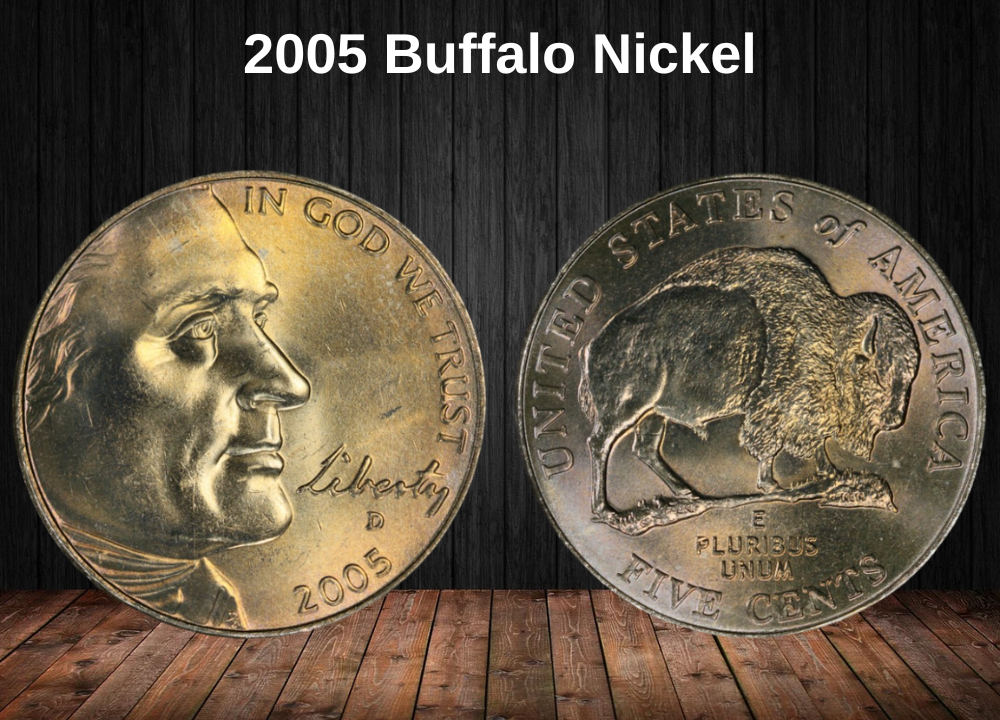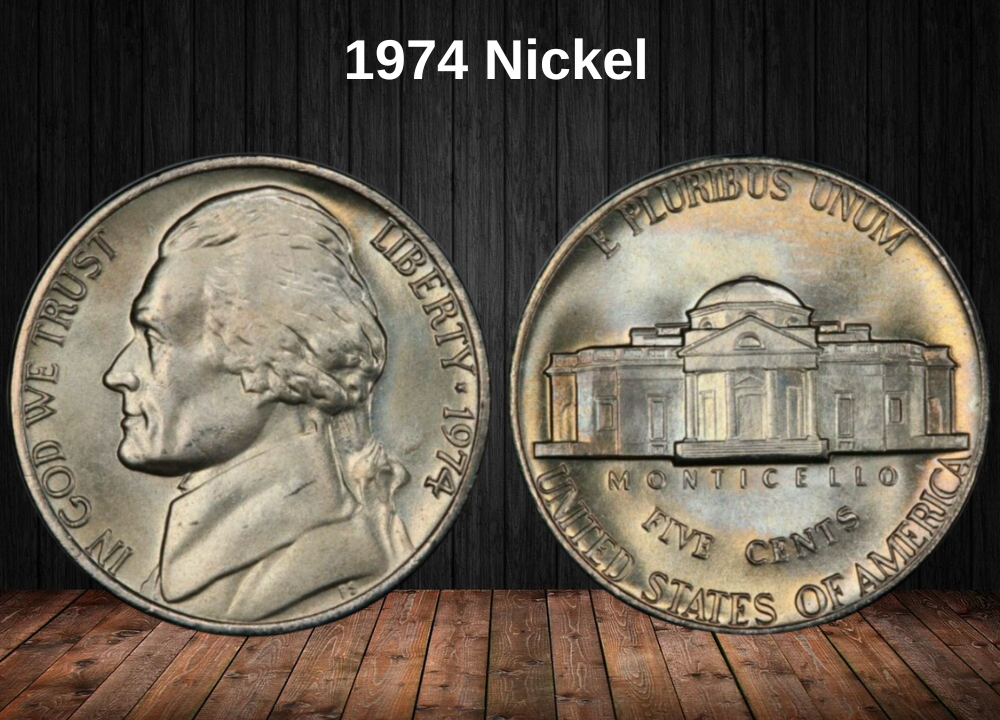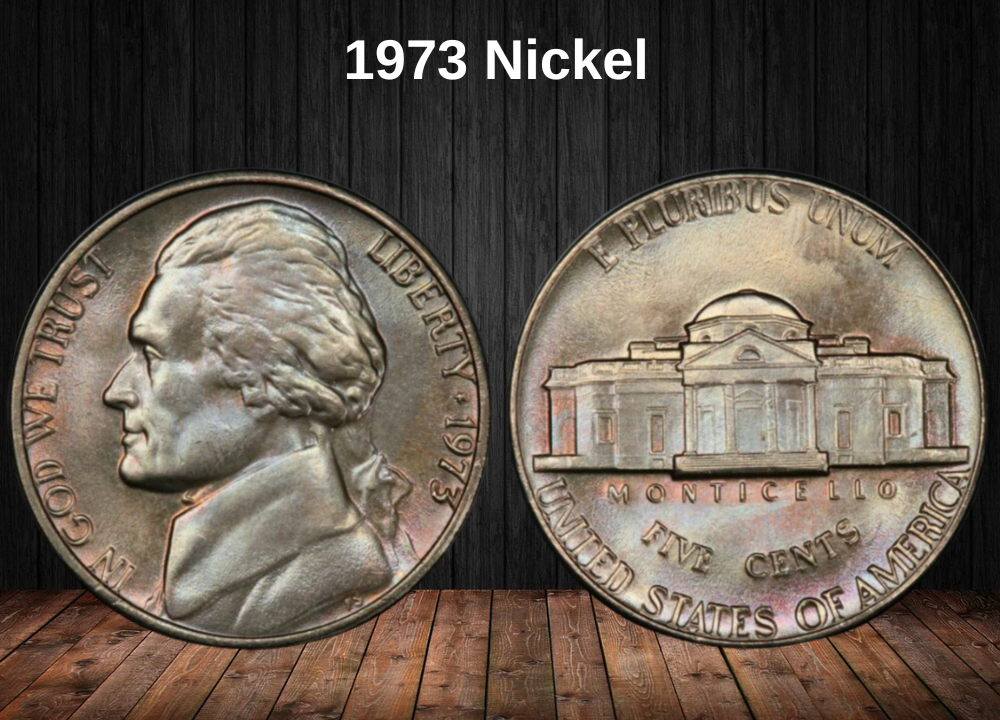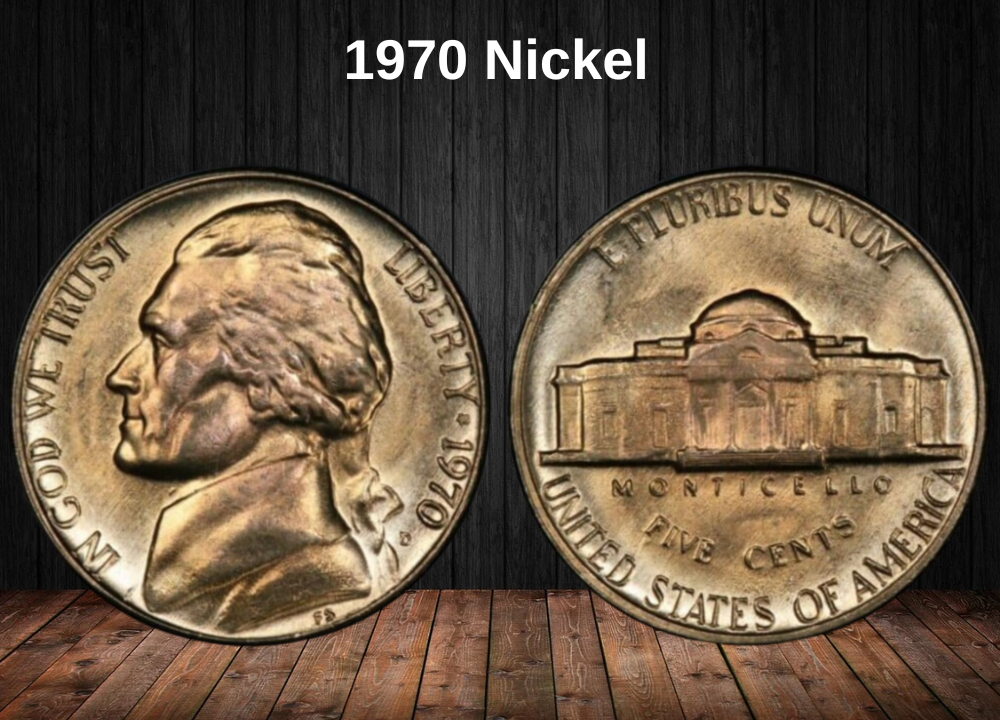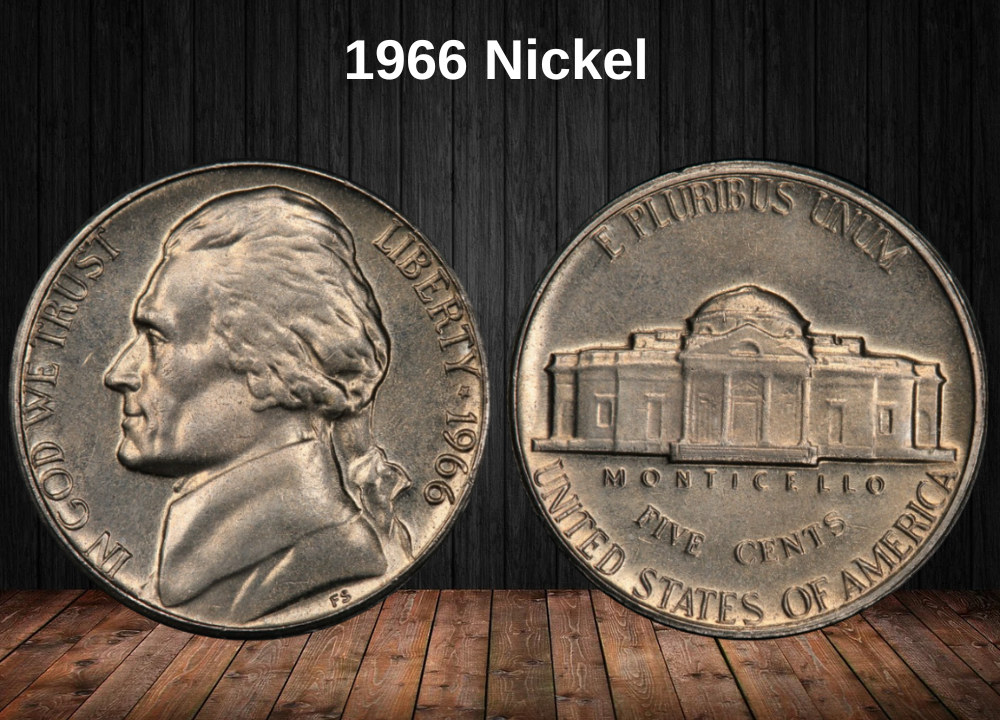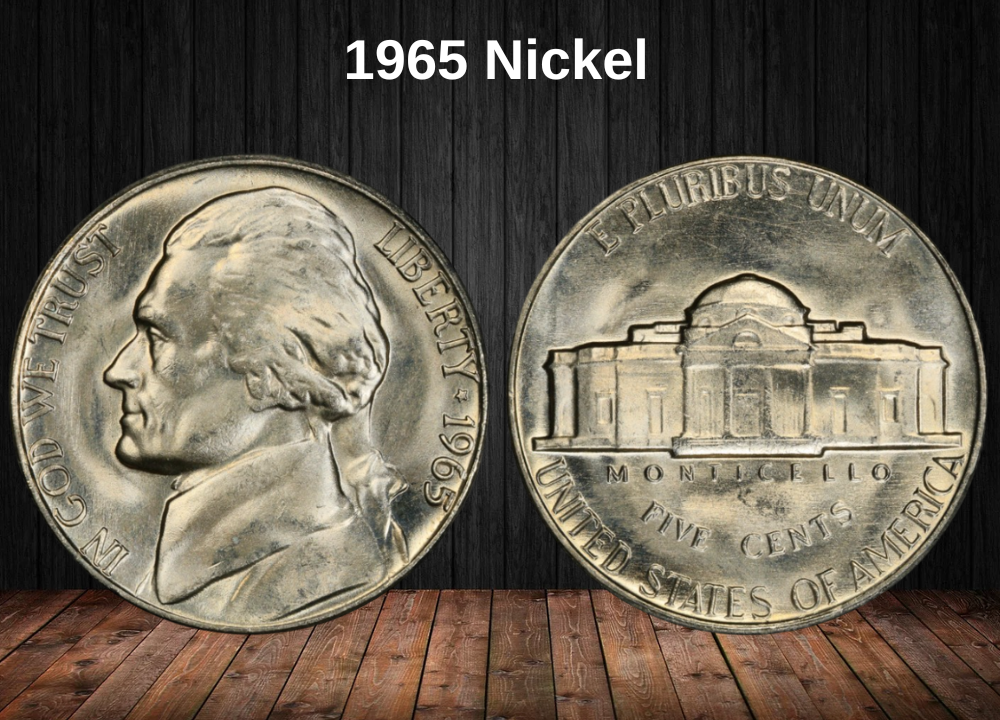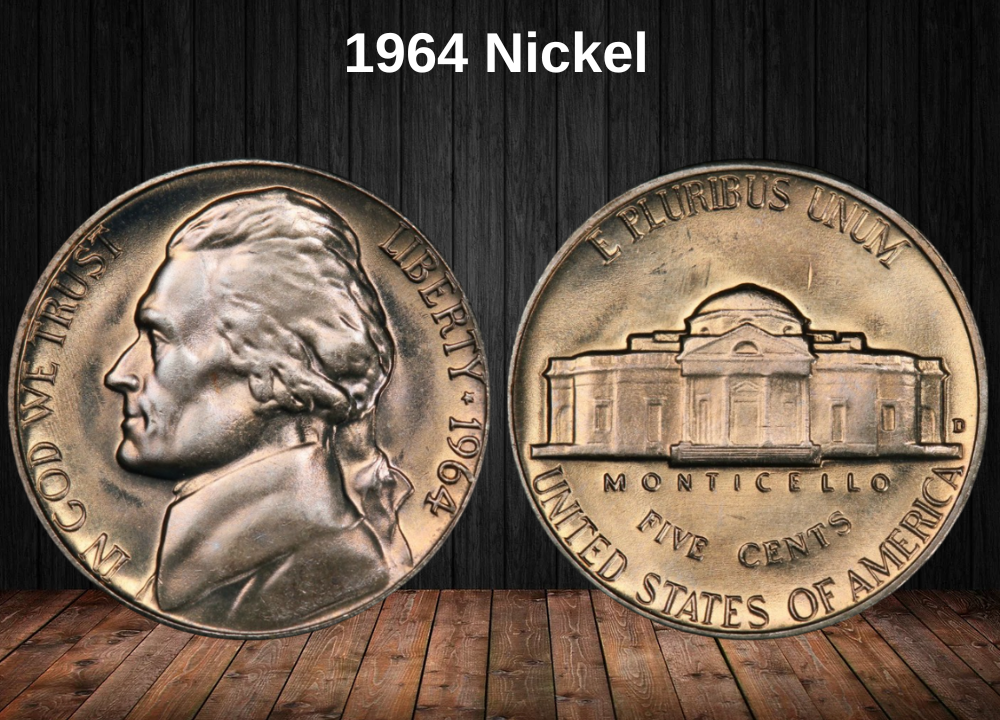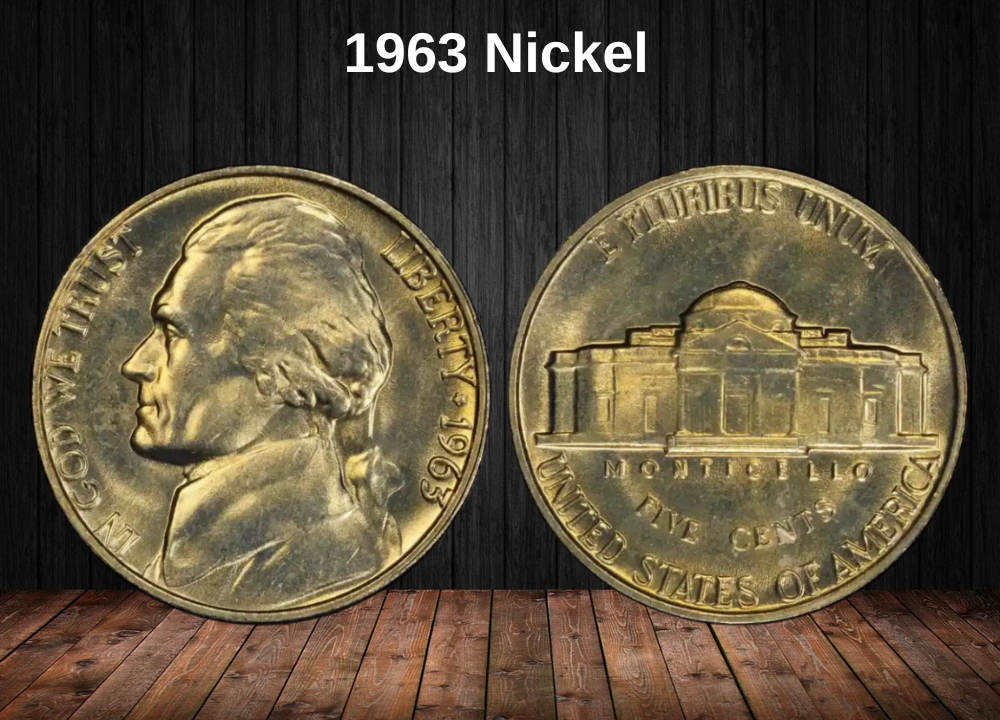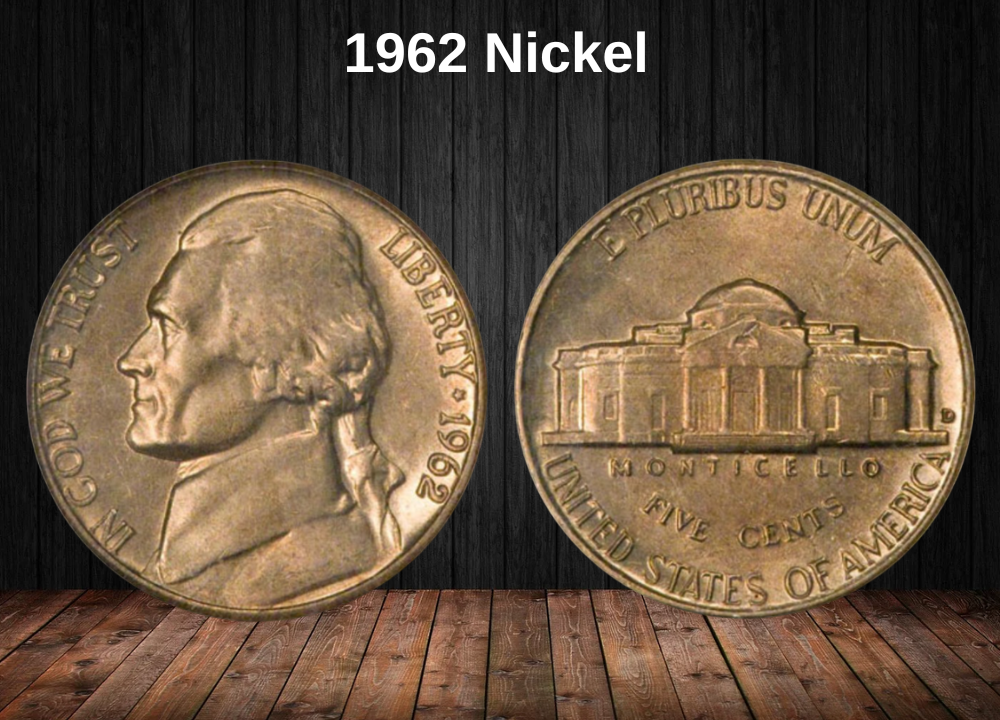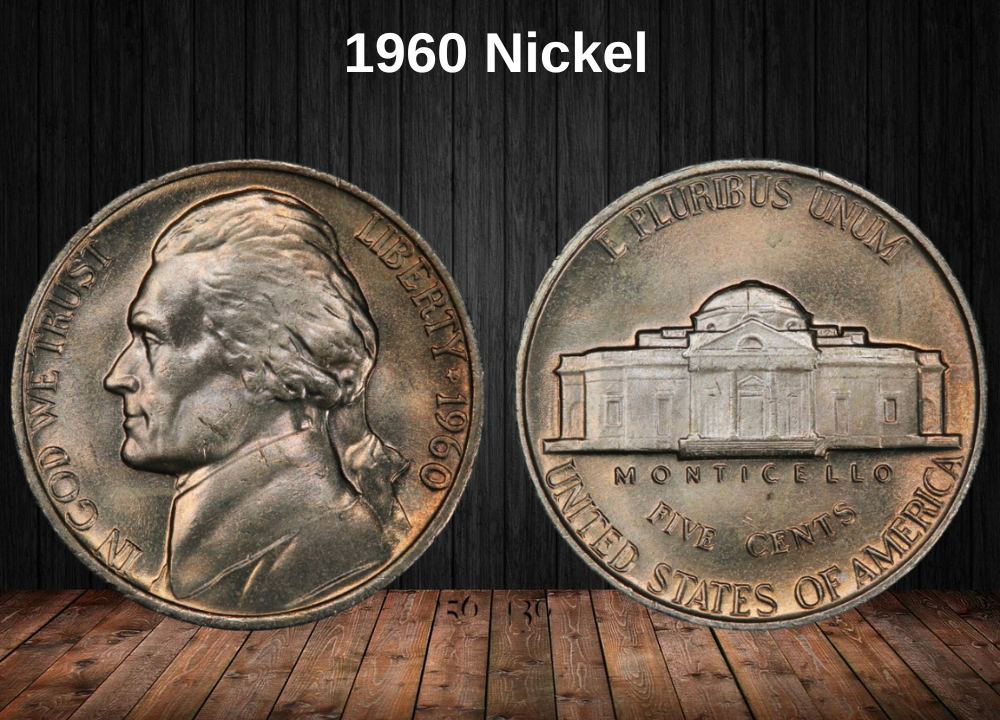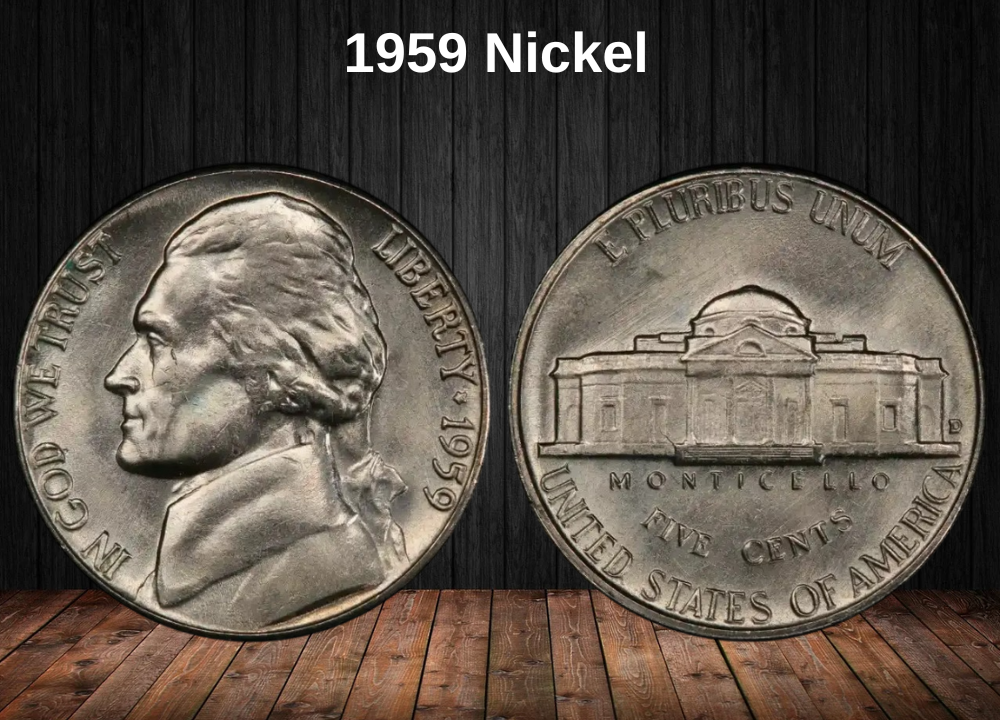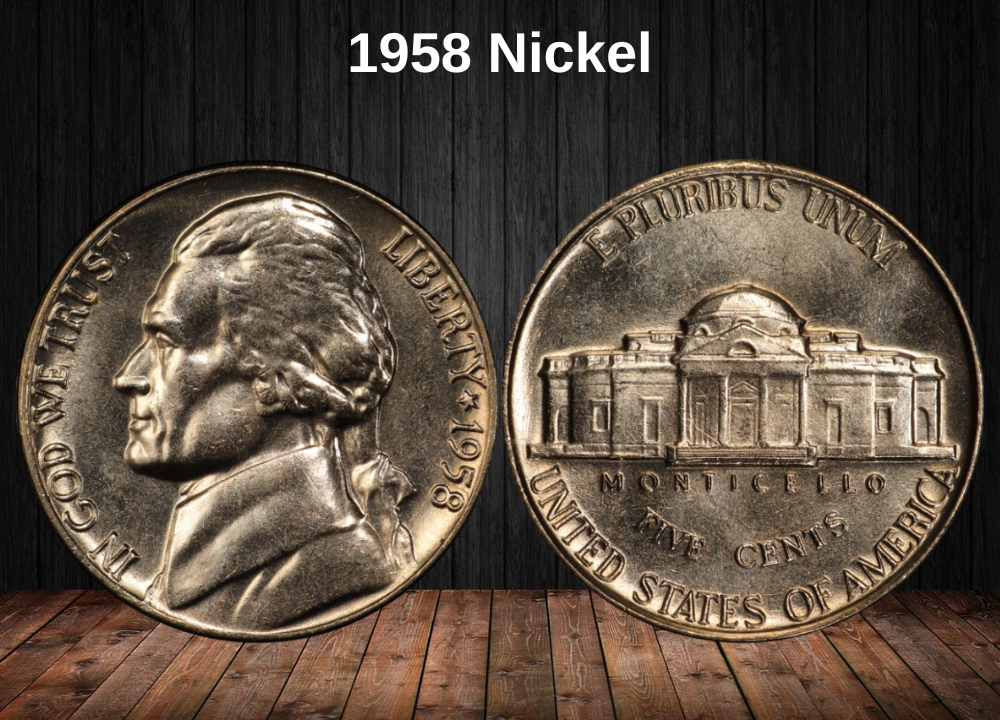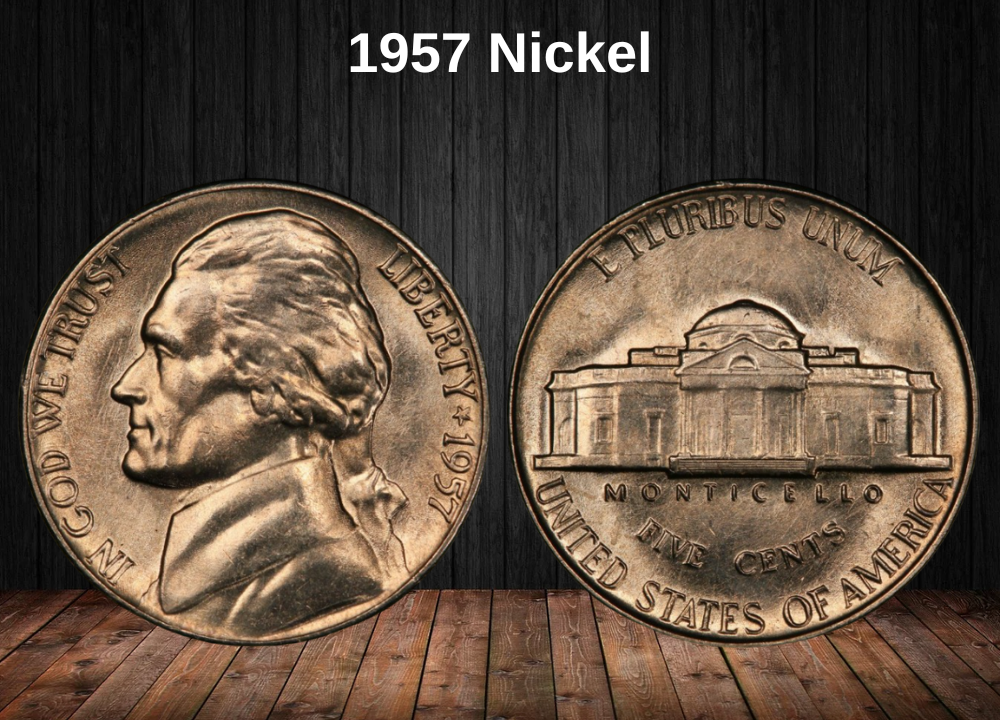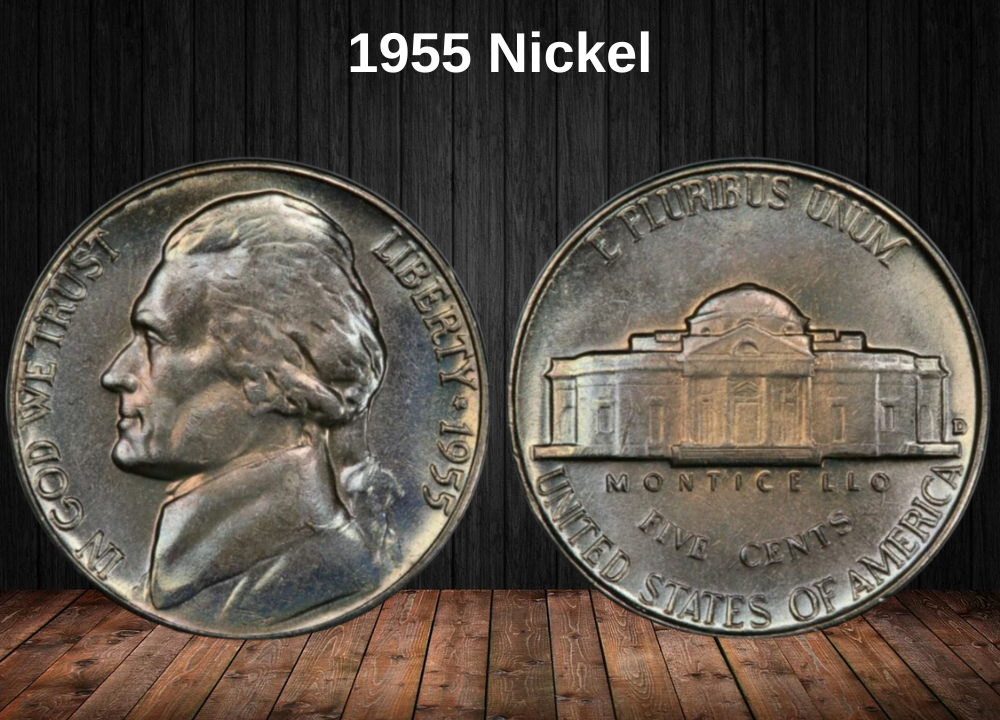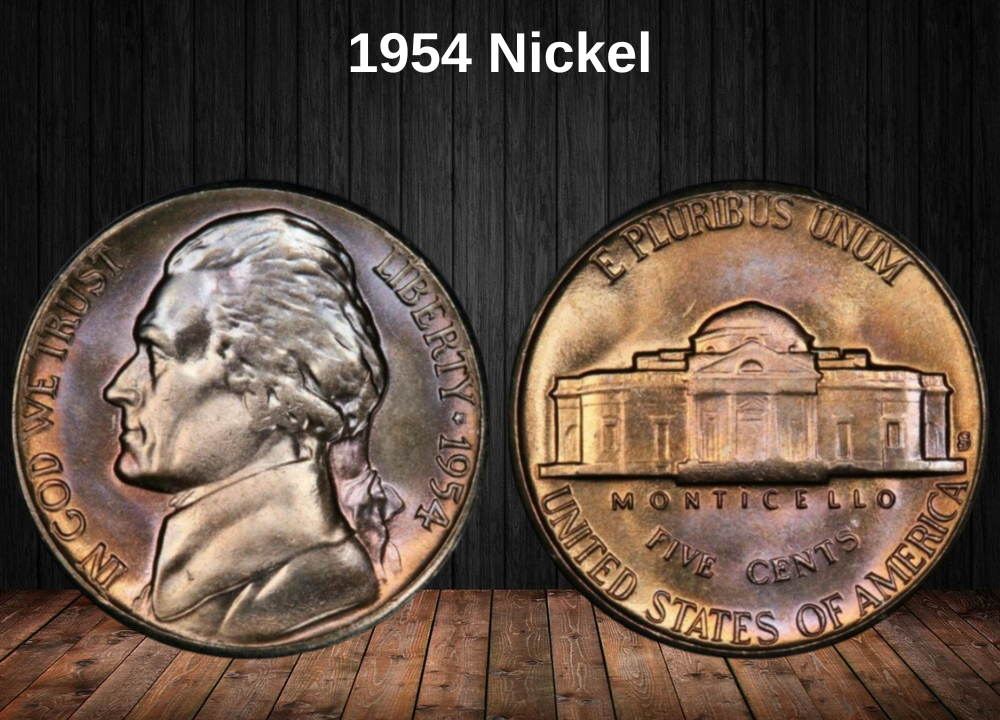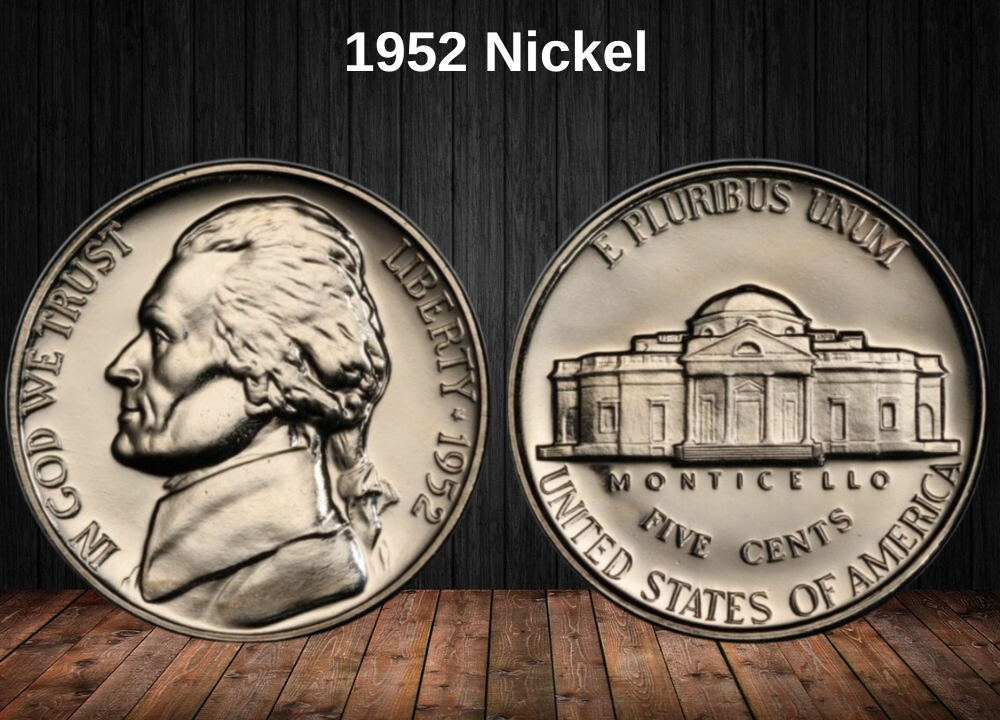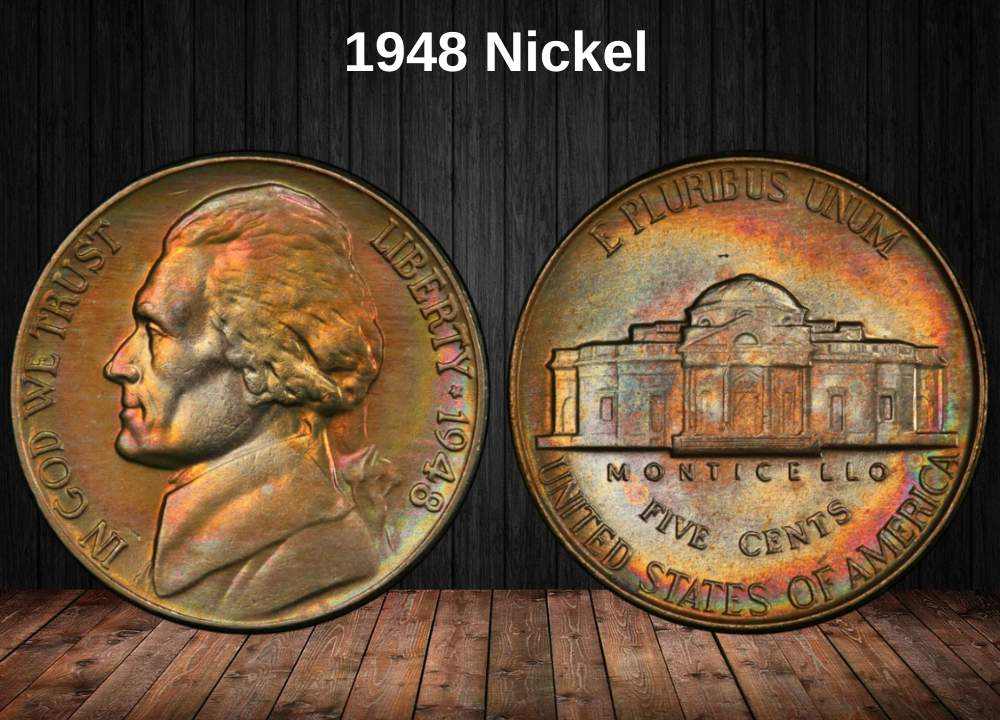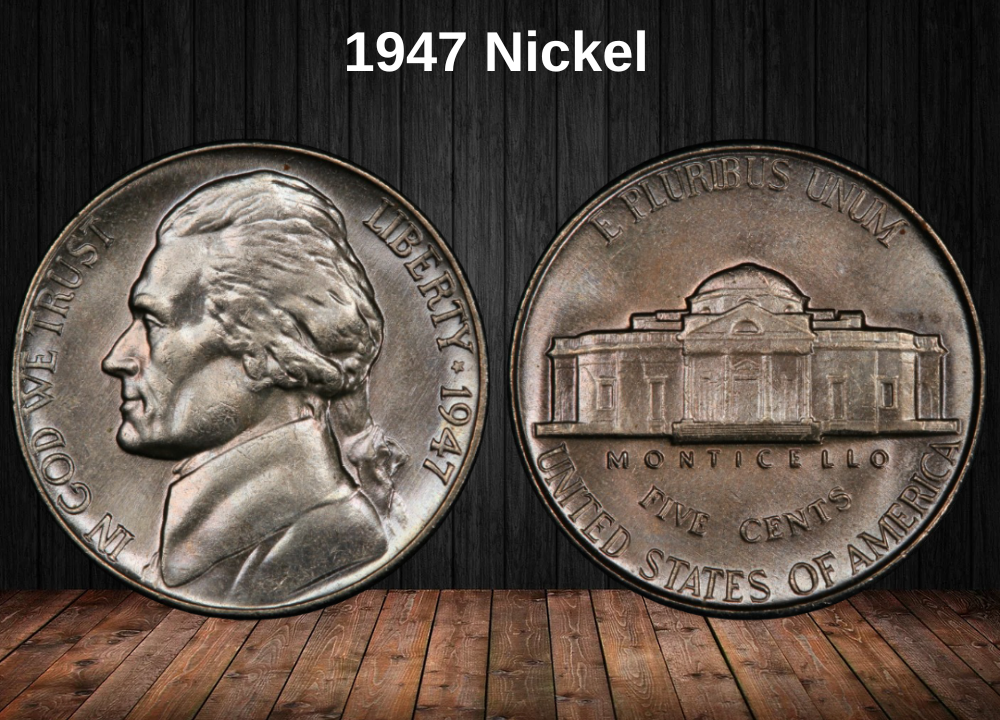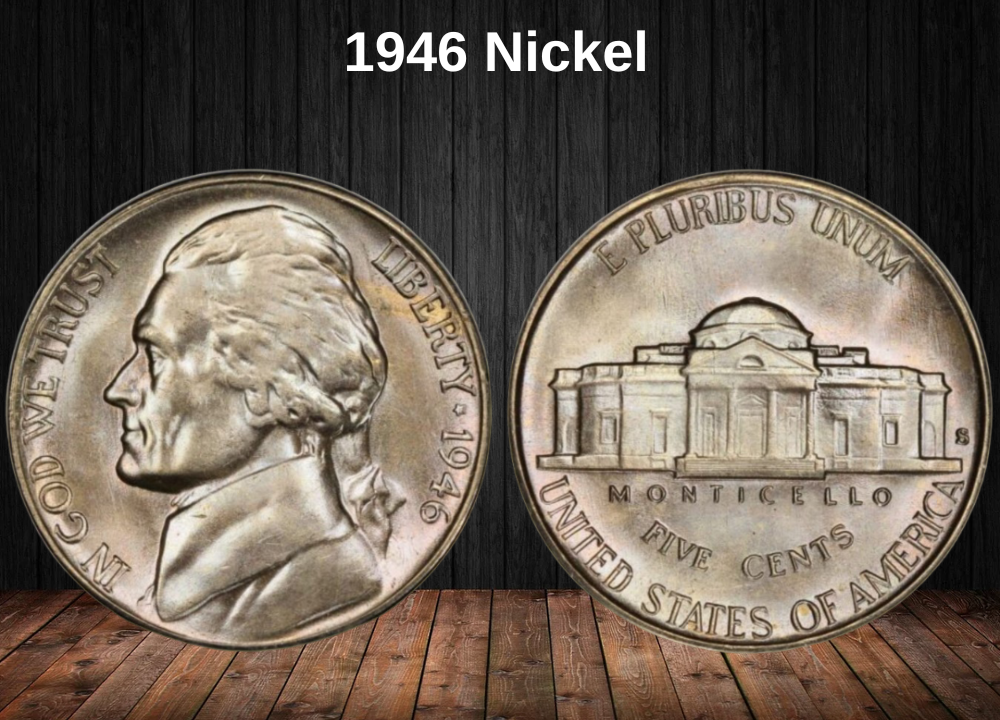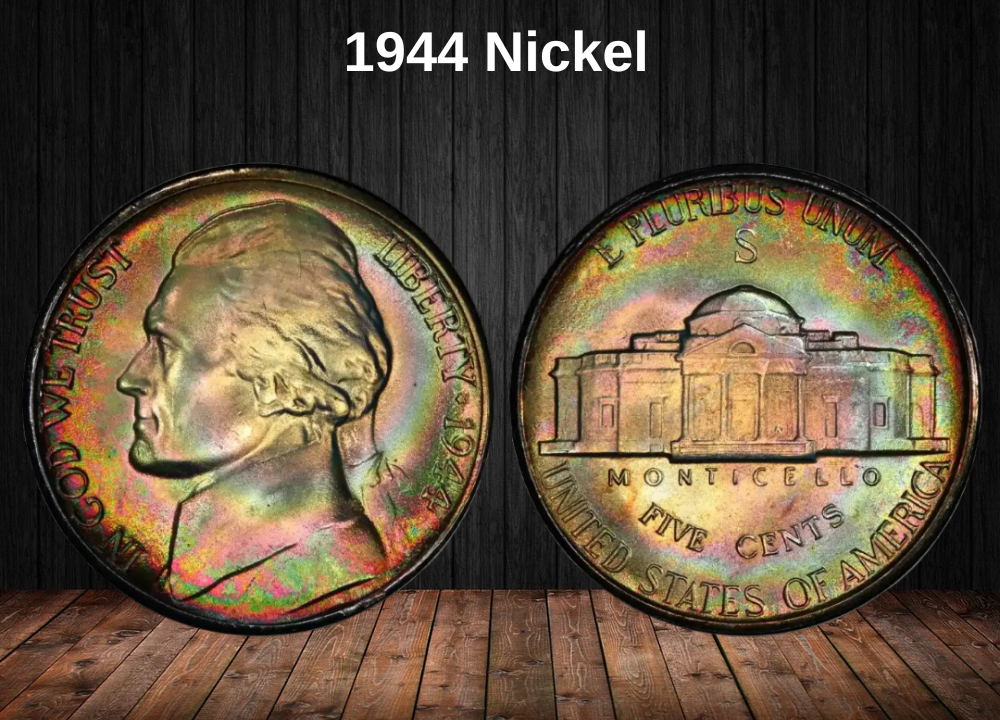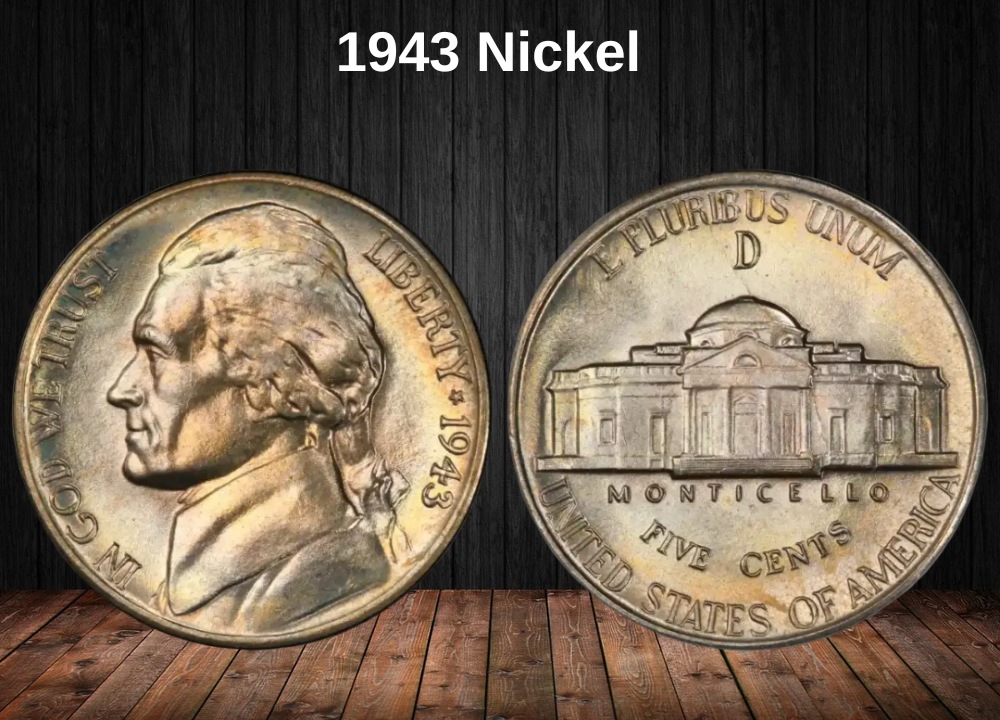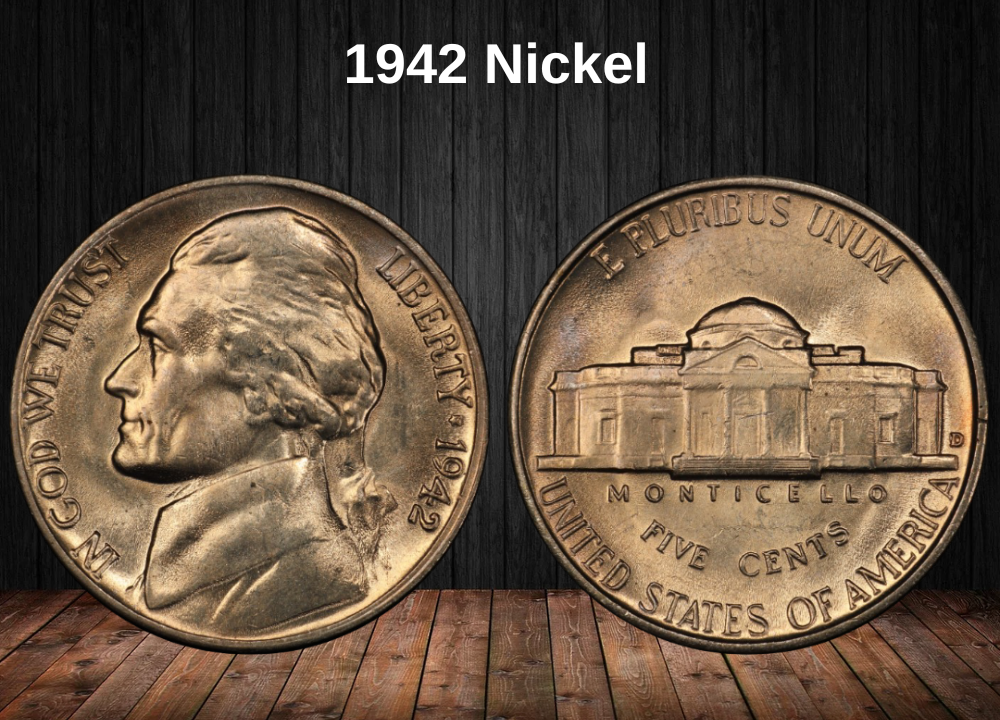In 1979, the U.S. Mint launched the Susan B. Anthony Dollar, shifting much of the attention away from other denominations. However, Jefferson nickels from this year remain interesting to collectors, especially due to a notable minting variety in the San Francisco Proof issue.
While most 1979 nickels are common in circulation, Full Steps examples and rare proof varieties can be worth a premium, with certain Denver Full Steps coins reaching thousands at auction.
1979 Jefferson Nickel Value Chart
| Coin Variety | MS 60 | MS 62 | MS 64 | MS 66 | MS 67 | PR/PF 70 DCAM |
|---|---|---|---|---|---|---|
| 1979 No Mint Mark Nickel | $1 | $3 | $10 | $85 | – | – |
| 1979 No Mint Mark Nickel (Full Steps) | $5 | $10 | $20 | $950 | – | – |
| 1979-D Nickel | $1 | $3 | $8 | $42 | – | – |
| 1979-D Nickel (Full Steps) | $2 | $4 | $14 | $135 | $8,250 | – |
| 1979-S Proof Nickel (Type 2 Clear-S) | – | – | – | – | – | $300 |
History of the 1979 Jefferson Nickel

The U.S. nickel, worth five cents, has a long and interesting history. Before becoming the familiar cupronickel coin we know today, it began as a half dime—a small silver coin sometimes spelled half disme and pronounced half deem.
During the Civil War, Americans began hoarding gold and silver coins as a way to preserve wealth, which caused a shortage of circulating currency. To fill the gap, the government issued small-denomination paper notes worth three to five cents. Unfortunately, these unstandardized notes varied by state and region, making counterfeiting a common problem.
To solve this, the U.S. Mint began experimenting with base metal coins. In 1865, it introduced a three-cent cupronickel coin, and the following year, the first five-cent cupronickel coin was minted. By 1873, silver 3¢ and 5¢ coins were discontinued, and the new nickel composition—75% copper and 25% nickel—became the standard, a formula still used today.
The Jefferson Nickel Design Transition
In 1938, the Buffalo Nickel was replaced with the Jefferson Nickel, featuring the 3rd U.S. President, Thomas Jefferson, on the obverse and his Virginia estate, Monticello, on the reverse. This design, created by artist Felix Schlag, was still in use in 1979.
Over the years, the design saw only minor adjustments, with major changes occurring in 2004 and 2005 to honor the Lewis and Clark expedition. Afterward, the reverse design reverted to Monticello, and in 2006, a new, more modern Jefferson portrait was introduced.
Wartime Silver Nickels (1942–1945)
Although nickels are generally made from copper and nickel, there was one exception—Wartime Nickels. Between 1942 and 1945, both nickel and copper were needed for military production during World War II. The Mint replaced part of the copper with 35% silver and 9% manganese, reducing copper content to 56%. These coins can be identified by large mint marks above Monticello on the reverse.
Features of the 1979 Jefferson Nickel
In coin terminology, the heads side is called the obverse, the tails side is the reverse, the thin edge is the rim, and the raised border is the collar. Some coins have ridges along the edge—called reeding—but the Jefferson Nickel has a smooth (plain) edge. The engraved text is referred to as legends or mottos, while the images are called devices. The flat background area is the field, and the blank metal disc before striking is known as a planchet.
Obverse Design
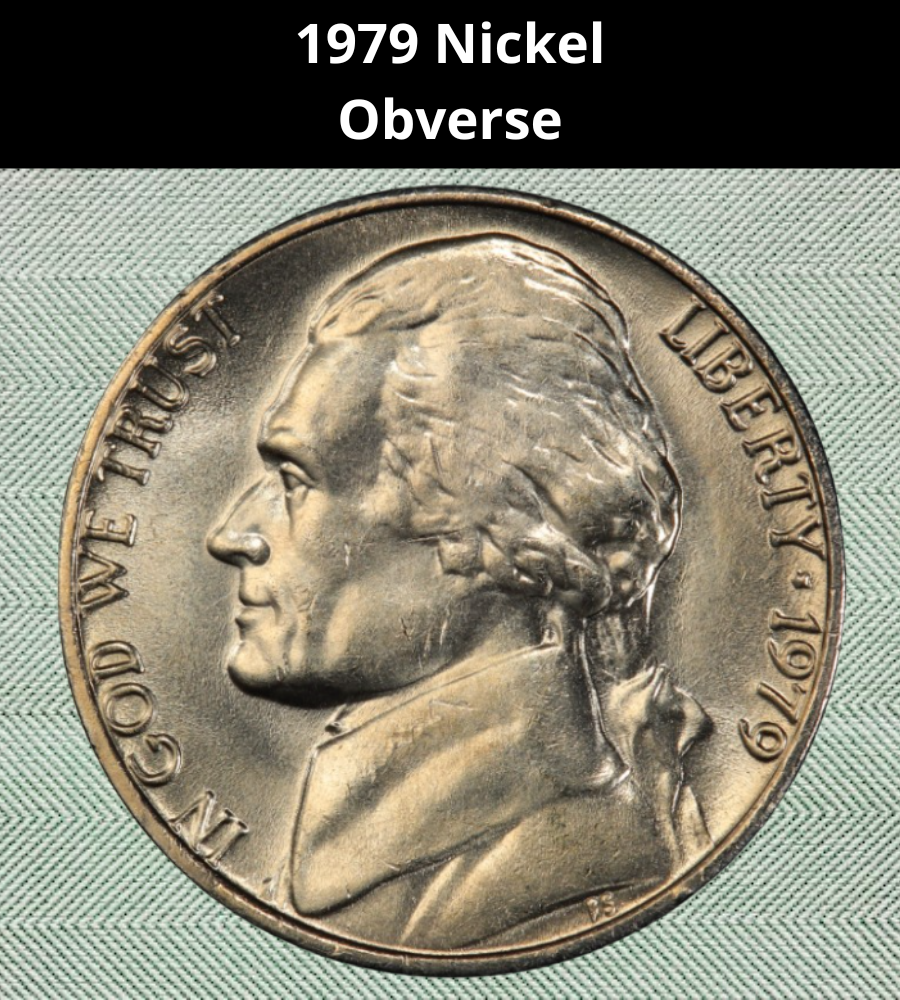
The obverse (front) of the 1979 Jefferson Nickel features a left-facing portrait of Thomas Jefferson, the 3rd President of the United States, designed by Felix Schlag.
Key design details include:
- IN GOD WE TRUST – positioned along the left side in front of Jefferson’s face.
- LIBERTY • [Date] – placed behind Jefferson’s head, separated by a small five-pointed star.
- Mint Mark – appears just after the date for coins struck in Denver (D) or San Francisco (S). Philadelphia coins have no mint mark.
- FS – the initials of designer Felix Schlag, located beneath Jefferson’s shoulder truncation.
Reverse Design
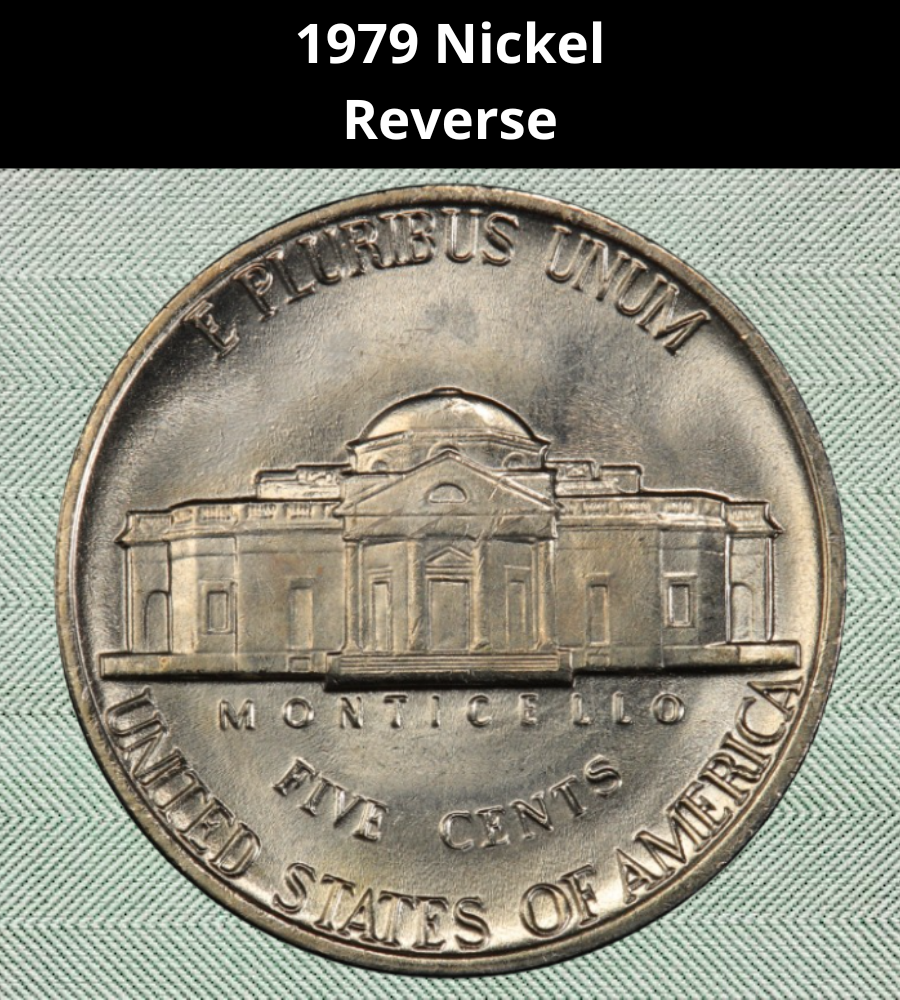
The reverse (back) displays Jefferson’s famous home, Monticello, centered as the main device. The neoclassical building is depicted with intricate architectural details.
Surrounding inscriptions include:
- E PLURIBUS UNUM – placed in an arc along the upper rim.
- MONTICELLO – directly below the building illustration.
- FIVE CENTS – curved along the lower portion, indicating the denomination.
- UNITED STATES OF AMERICA – encircling the bottom edge.
Physical Specifications
- Composition: 75% copper, 25% nickel (cupronickel alloy)
- Diameter: 21.21 mm
- Thickness: 1.95 mm
- Weight: 5 grams
- Edge: Plain (smooth, no reeds)
1979 Jefferson Nickel Grading Guide
The Sheldon Coin Grading Scale is the industry standard for evaluating coin condition, ranging from 1 (Poor) to 70 (Perfect Mint State). The higher the grade, the sharper the details, the cleaner the surfaces, and the greater the coin’s potential value.
For Jefferson Nickels, an additional factor—Strike Quality—is extremely important to collectors. This is measured by the visibility of the steps on Monticello (on the reverse).
- Full Steps (FS): Coins with five visible steps (5FS)
- Six Full Steps (6FS): Coins with all six steps fully separated and clearly defined. These are the most desirable and can command significant premiums, especially in higher grades.
Sheldon Scale Grades for the 1979 Jefferson Nickel
| Grade # | Grade Name | Description |
|---|---|---|
| 1 | Basal State-1 | Barely identifiable; heavily worn, often damaged. |
| 2 | Fair | Major details missing; outlines barely visible. |
| 3 | Very Fair | Some detail visible, but still heavily worn. |
| 4–6 | Good | Main designs outlined, but with heavy wear and no fine details. |
| 7–10 | Very Good | More design elements visible, but still lacking finer details. |
| 12–15 | Fine | Moderate wear; some inner details visible. |
| 20–30 | Very Fine | Light to moderate wear on high points; most details remain. |
| 40 | Extremely Fine | Light wear; strong detail and visible design texture. |
| 50 | About Uncirculated | Only slight wear on the highest points; nearly full detail. |
| 60 | Mint State (MS 60) | No wear; may have noticeable contact marks or dull luster. |
| 65 | Mint State (MS 65) | High-quality strike, strong luster, minimal marks. |
| 70 | Mint State (MS 70) | Perfect coin; flawless under 5× magnification. |
1979 Jefferson Nickel Value Guide
In 1979, the U.S. Mint produced Jefferson Nickels at three facilities—Philadelphia, Denver, and San Francisco. Each mint’s coins carry their own market value, largely determined by mintage numbers, strike quality, and collector demand. Regular strikes (business strikes) were intended for circulation, while proof coins from San Francisco were made for collectors.
1979 No Mint Mark Nickel Value (Philadelphia)
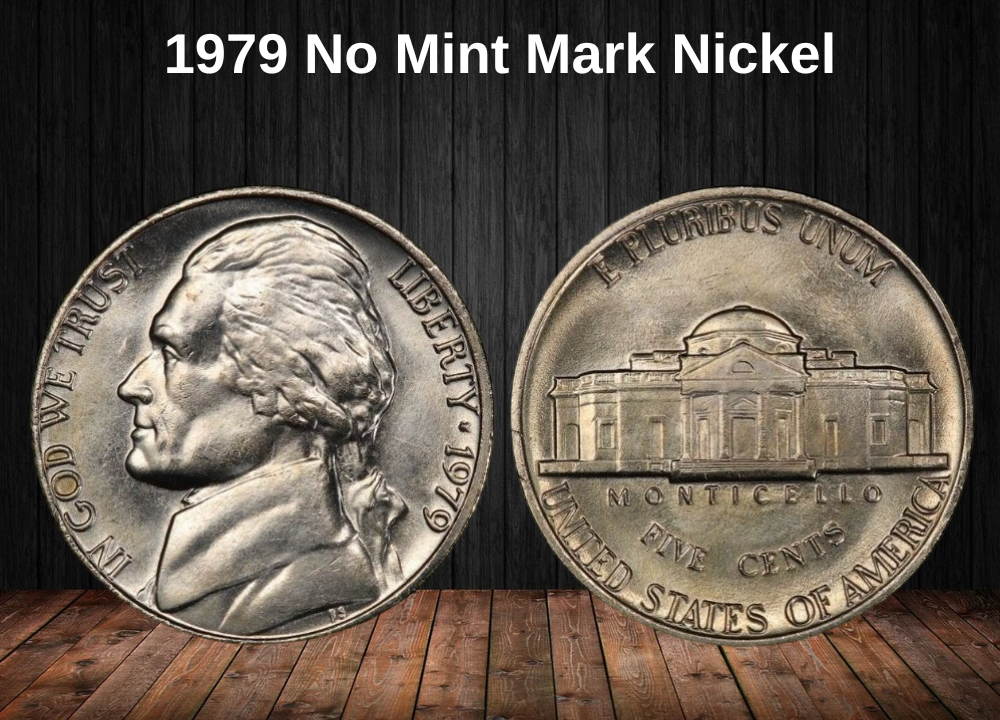
The Philadelphia Mint struck 463,188,000 nickels in 1979, all without a mint mark. These coins are widely available, meaning only higher-grade examples hold notable value.
- Historic Sale: On July 30, 2003, a 1979 MS 63 sold for $1,898.
- Current Market: By 2025, that same grade is worth about $6.
- Higher Grades: An MS 66 sells for around $85, with only one coin graded MS 66+ by PCGS, valued at $115.
Full Steps (FS) Values:
- MS 66 FS – Sold for $2,115 in 2016; now valued at $950 (20+ known).
- MS 65 FS – About $275 (nearly 40 known).
- MS 60 FS – Around $5, still 100× face value.
1979-D Nickel Value (Denver)
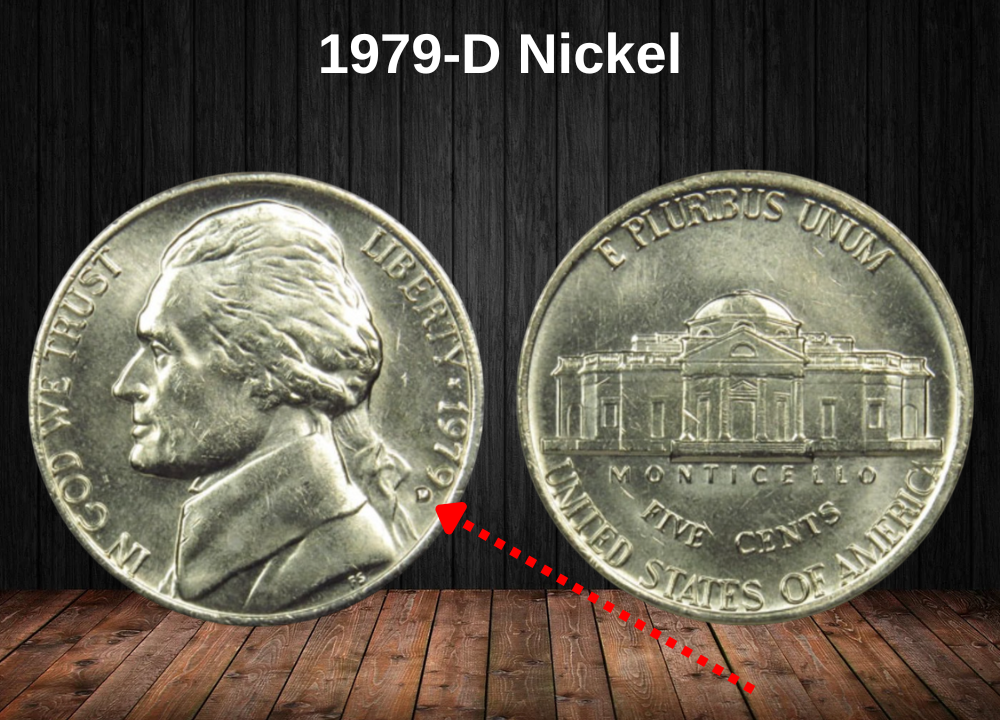
The Denver Mint produced 325,867,672 nickels in 1979, marked with a “D.” Circulated coins typically hold little premium, but high-grade examples and Full Steps coins can be valuable.
- Historic Sale: An MS 67 sold for $345 in 2008 (NGC-graded).
- Current Market: PCGS has yet to record higher than MS 66, valued at $42 in 2025.
Full Steps (FS) Values:
- MS 67 FS – Sold for $4,500 in 2022; estimated at $8,250 in May 2025 (only 1 known).
- MS 66 FS – About $135 (70 known).
- MS 65 FS – Around $20 (150+ known).
1979-S Proof Nickel Value (San Francisco)
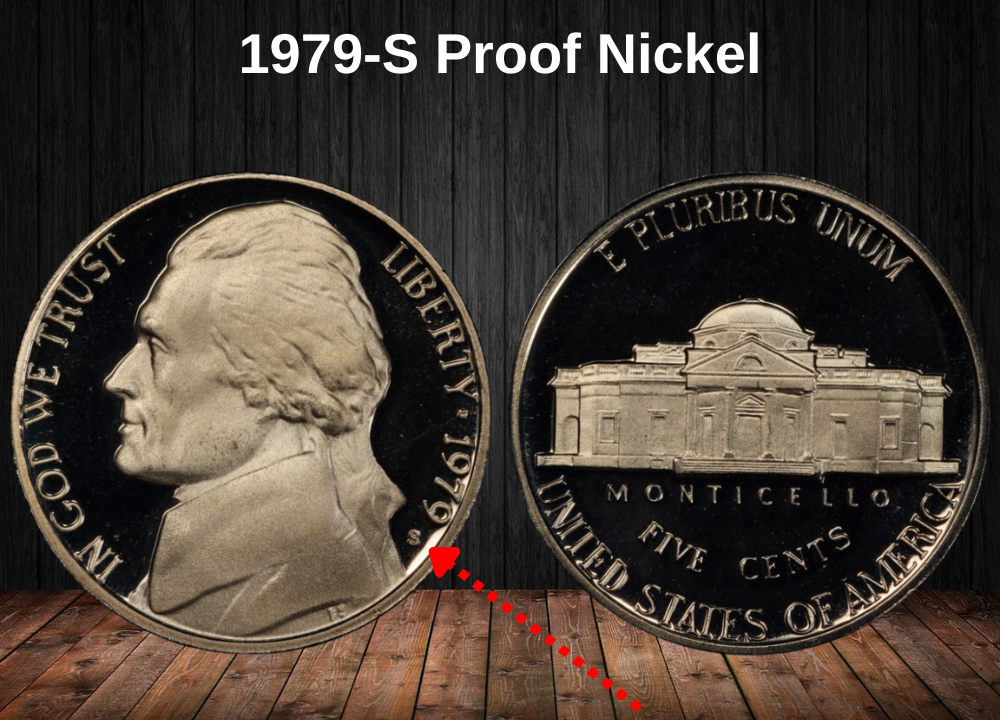
The San Francisco Mint issued proof nickels exclusively for collectors. These coins feature mirrored fields and frosted devices, typically graded as Deep Cameo (DCAM) in high-quality strikes.
Two varieties were produced in 1979:
- Type 1 (FS-501 Filled-S) – A mint error, discussed in the Errors section.
- Type 2 (Clear-S) – The standard variety.
Notable Prices:
- PR 70 DCAM – Sold for $2,530 in 2008; with nearly 200 known today, value has adjusted to $300 in 2025.
- PR 69 DCAM – Around $15 (over 8,000 graded by PCGS).
Rare 1979 Jefferson Nickel Errors List
Mint errors can significantly increase a coin’s value, especially when they occur early in production. Early-discovered flaws—spotted within 30 days of a coin’s release—are called first-strike errors and often receive official FS numbers. For the 1979-S Proof Nickel, the most notable example is the FS-501 Filled-S variety.
Below are the most recognized and valuable 1979 nickel errors.
1. 1979-S Proof Nickel Filled-S (Type 1) – FS-501
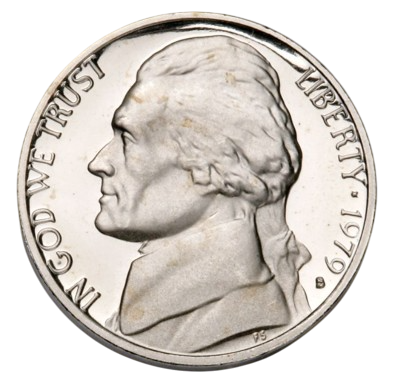
- Description: Mint mark “S” has filled loops, giving it a solid, blurry appearance.
- Cause: Hand-punched mint mark error on the master die.
- Value: PR 70 DCAM sold for $1,763 in 2013; worth about $80 in 2025.
2. 1979 (P) Nickel Struck 60% Off-Center
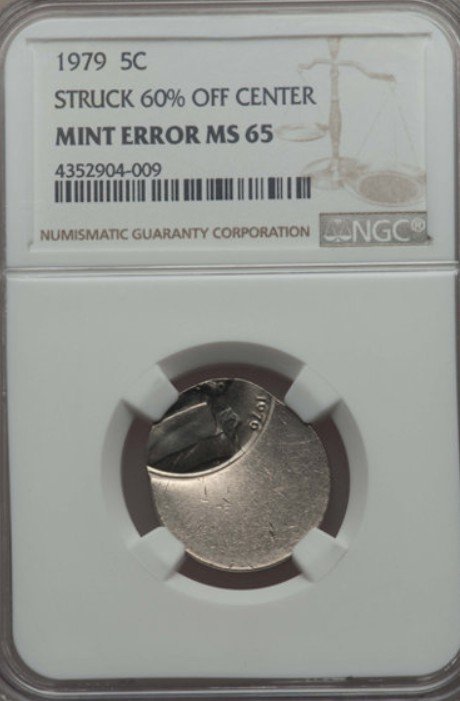
- Description: Large blank area where the design is missing due to misalignment.
- Value: MS 64 sold for $46; MS 66 for $62.
3. 1979 (P) Nickel Struck Thru Late Stage Die Cap
- Description: Obstruction from a stuck planchet caused a distorted strike.
- Value: Around $47 in AU 58 grade.
4. 1979 (P) Nickel 35% Off-Center on a Curved Clip Planchet
- Description: Coin struck on scrap metal from the blanking process, creating a curved clip and off-center design.
- Value: About $65.
5. 1979 (P) Nickel Double Struck 85% Off-Center with Flipover
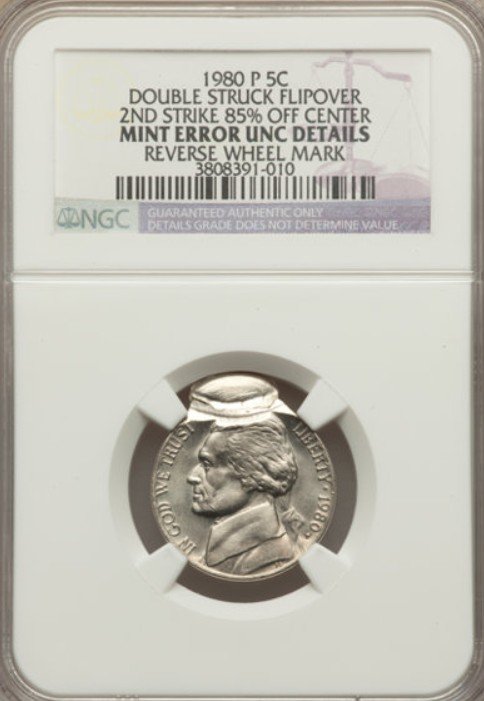
- Description: Coin was struck twice; second strike was on the opposite side and heavily off-center, distorting shape.
- Value: $95 in MS 62 grade.
6. 1979 (P) Nickel Struck on a Penny Planchet
- Description: Struck on a copper 1¢ blank, making the coin red-toned, lighter (≈3g), and missing parts of the design.
- Value: $158 to $424, depending on condition.
7. 1979 (P) Nickel Defective Planchet Error

- Description: Lamination cracks, blowholes, or splits from flawed metal quality.
- Value: Blow hole example sold for $250 (AU 58); lightning bolt crack at $200 (MS 65).
8. 1979-D Nickel Double Struck with Rotation and Reverse Indent
- Description: Double strike combined with misaligned rotation; words on reverse overlap.
- Value: $150 in MS 65 grade.
9. 1979-D Nickel Double Struck 65% Off-Center with Reverse Brockage
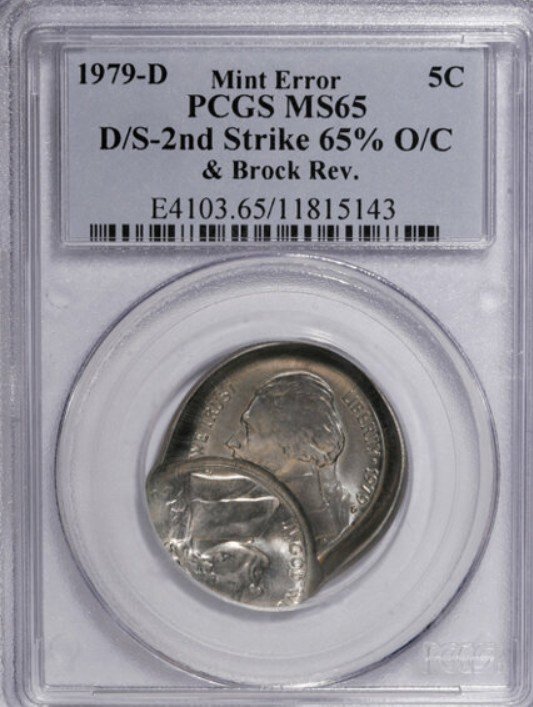
- Description: Double strike, heavy off-center, and reverse brockage from die cap obstruction.
- Value: $550 in MS 65 grade.
10. 1979 Nickel 20% Off-Center on a Penny Planchet
- Description: Combination error—nickel design struck on a copper penny planchet and misaligned by 20%.
- Value: Over $1,000 in MS 65 RD.
Where to sell your nickel?
Now that you’re aware of your nickel’s value, you may be curious about the best places to sell it. Don’t worry: here’s a rundown of some top online marketplaces where you can conveniently sell your nickels, along with their benefits and drawbacks.
Explore the best platforms for selling nickels online (advantages and disadvantages).
1979 Nickel FAQ
Does a 1979 nickel have a mint mark?
Yes. Coins from San Francisco (S) and Denver (D) have their mint mark on the obverse, just after the mint date. Philadelphia nickels struck in 1979 have no mint mark.
How much is a 1979-S nickel worth?
A 1979-S Type 1 Filled-S Proof Nickel in PR 70 DCAM is worth around $80 today. Despite being a perfect grade, the value is modest because over 350 have been graded at that level by PCGS.
- PR 69 DCAM is worth about $15 (10,000+ graded).
For the 1979-S Type 2 Clear-S Proof Nickel: - PR 70 DCAM sells for $300 (≈200 graded).
- PR 69 DCAM sells for $15 (7,500+ graded).
What is the most valuable 1979 nickel?
The highest sale so far is a 1979-D Nickel (Full Steps) in MS 67, which sold for $4,500 in 2022 and is valued at $8,250 in 2025 due to extreme rarity in that grade.
What are Full Steps (FS) nickels?
A “Full Steps” designation means the steps on Monticello’s entrance are sharply struck and fully visible. The best examples have 6 full steps, but 5-step coins can also carry premiums.
How much is a 1979 no mint mark nickel worth?
Circulated examples are generally worth face value.
- MS 66 sells for around $85.
- MS 66 FS is worth $950 in 2025, with the auction record at $2,115 (2016).
What are common errors on 1979 nickels?
Notable errors include:
- Filled-S mint mark (Type 1 Proofs)
- Off-center strikes
- Wrong-planchet strikes (especially penny and steel washer planchets)
- Double strikes and brockages
Some of these errors can sell for hundreds or even thousands of dollars.
Why are some 1979 nickels copper-colored?
Those are usually wrong-planchet errors where the nickel design was struck on a copper 1¢ blank. They weigh around 3g and often have parts of the design missing due to the smaller planchet size.
Is the 1979 nickel made of silver?
No. All standard 1979 nickels are 75% copper and 25% nickel. The only U.S. nickels that contained silver were wartime issues from 1942 to 1945.
What is the weight of a 1979 Jefferson nickel?
A regular 1979 nickel weighs 5 grams. Wrong-planchet errors (like penny or dime planchets) weigh less.
Where is the designer’s initials on a 1979 nickel?
The initials FS (for Felix Schlag) are engraved under Jefferson’s shoulder on the obverse.
Why are proof nickels shinier than regular ones?
Proof coins are struck with specially prepared dies and polished planchets, giving them mirror-like fields and frosted designs. Many 1979 proofs are DCAM (Deep Cameo), with strong contrast between the devices and fields.

